1Biology Department, Faculty of Science, King Abdulaziz University Jeddah, Saudi Arabia.
2Botany Department, Faculty of Science, Kafrelsheikh University, Kafr El Sheikh, 33516 Egypt.
Corresponding author email: magdammali@hotmail.com
Article Publishing History
Received: 15/07/2021
Accepted After Revision: 27/09/2021
When some bacteria grown in increasing concentrations of carbon, a polymer called Poly β- hydroxyl butrate (PHB) was produced and accumulated inside the bacterial cell up to 70% of the cell dry weight. This material can be used safely in different modern application to replace plastic which has negative effects on man, animals and environments. This study aimed to isolate some actinomycetes for PHB degradation and optimization the growth conditions for maximum degradation. Contaminated soil samples were collected from industrial area of Jeddah and used for actinomycete isolations.
The isolated bacteria were screened on medium containing PHB as a carbon source and presence of cleat zone on solid agar medium around the bacterial colonies mean PHB degradation. Out of thirty isolates, eight isolates were the most active in PHB degradation. After growth in liquid medium, these isolates were identified and characterized using morphological, physiological and chemical methods. Using molecular methods, they were belonging to different genera of actinobacteria.
The most active isolate was Streptomyces sp. MM21.The effects of some growth factors on growth and PHB degradation was determined. Growth was measured by dry weight (g/l) while PHB degradation was detected by depolmerase assay (U/ml). It was clear that addition of 2.5 g/l of yeast extract and 1 g/l glucose enhanced both growth and PHB degradation. Similarly, adjusting medium at pH 7.0 and incubation temperature at 25°C for 7 days lead to maximum PHB degradation. The maximum growth was in medium containing 0.5 g/l of PHB. In conclusion, PHB degradation was detected by actinobacteria and was affected by some physical and biochemical factors. It was noticed that optimization of growth conditions enhanced both growth and degradation process by the selected Streptomyces isolate.
Contamination, Degradation, Identification, Phb, Streptomyces, 16sr Rna
Aboras M, Alzahrani E. J, Aly M. M. Molecular Identification of Some Filamentous Bacteria Isolated from Contaminated soil for Poly Hydroxyl Butyrate Degradation. Biosc.Biotech.Res.Comm. 2021;14(3).
Aboras M, Alzahrani E. J, Aly M. M. Molecular Identification of Some Filamentous Bacteria Isolated from Contaminated soil for Poly Hydroxyl Butyrate Degradation. Biosc.Biotech.Res.Comm. 2021;14(3). Available from: <a href=”https://bit.ly/3t1kxHM“>https://bit.ly/3t1kxHM</a>
Copyright © Aboras et al., This is an open access article distributed under the terms of the Creative Commons Attribution License (CC-BY) https://creativecommns.org/licenses/by/4.0/, which permits unrestricted use distribution and reproduction in any medium, provide the original author and source are credited.
INTRODUCTION
Different used materials in our homes and factories are from petro-based plastics which have a variety of serious harmful effects on human health and aquatic environment due CO2 releases, ingestion of plastic and bis-phenol accumulation (Gervet, 2007, Halden, 2010). The worldwide annual production of synthetic polymers was many billion tons and now the disposal of these materials was of big concern. The decrease of plastic materials is urgent and developing biodegradable plastics as an alternative material is the solution (Shimao 2001, Sabapathy et al., 2021, Müller-Santos et al., 2021).
Pranamuda et al. (1995) reported that poly hydroxyalkanoic acids (PHA) and poly β-hydroxybutyrate (PHB) are biodegradable materials with properties similar to conventional plastics and can be used safely in our life. Biodegradable alternative polymers are environmentally-friendly obtained from renewable resources and most ecological studies were focused on PHB biodegradation. The distribution of bioplastic degrading bacteria in the environment has been investigated and the diversity or abundance of these microorganisms were recorded. The most active microbial population must be transferred from the lab. to the environment to enhance degradation process (Sabapathy et al., 2021).
Time is needed to utilize biodegradable plastics and maintain the health of the environment. Looking for microorganisms convert bio- polymers to monomers using effective eco-friendly methods is urged. Poly β- hydroxyl butrate is a polymer produced by many genera of bacteria up to 75% of the cell dry weight. These polymers were used by bacteria as reserved food but can be extracted, characterized and used in many countries as safe and eco-polymer.
Biodegradation of these polymers has been investigated in soils, composts and natural waters by bacteria and fungi which contained PHB depolymerases (Mergaert et al., 1994, 1995, Oda et al., 1997, Sharma et al., 2019) and rate of degradation depend on the properties of the polymers. PHB depolymerases are responsible for extracellular PHB degradation (Jendrossek and Handrick, 2002, Alhazmi et al., 2018, Alves et al., 2020).
Recently from a dumping yard rich in plastic wastes, Stenotrophomonas sp. RZS7 was isolated, characterized and grown for PHB depolymerase production during its growth. This enzyme was extracted and purified by ammonium salt precipitation, column chromatography and solvent purification (Sayyed et al., 2020, Alves et al., 2020). This study aimed to isolation and identification of actinobacteria from contaminated soil for degradation of PHB and optimization the degradation conditions for maximum activities.
MATERIAL AND METHODS
Sample collection and bacterial isolation and selection: Contaminated soil samples (10) from the industrial zone, Jeddah, Saudi Arabia were collected in sterile plastic bags, air dried and sieved. Different bacterial isolates were obtained on Starch nitrate agar after growing for 5 days at 25◦C and the pure isolates were maintained on the same medium in the refrigerator at 4oC until used. All isolated bacteria were screened on mineral salt agar medium containing PHB as carbon source and the most active isolates that showed the highest clear zones were selected and identified.
Bacterial identification: The locally isolated bacteria used in this study were from contaminated soil samples. The used medium for isolation was starch-nitrate agar. This medium contained (g/l): starch, 20; KNO3, 2; K2HPO4, 1; KH2PO4, 0.7; MgSO4·7H2O, 0.7; agar, 20. The medium pH was adjusted to 7. All isolate were purified and preserved on the same medium on slants at 4◦C. The selected isolates were identified according to International Streptomyces Project (Shirling and Gottlieb 1966). DNA was extracted and 16SrDNA genes of the active isolates were purified and sequenced. The sequence was analyzed and compared to 16SrDNA genes in the Ribosomal Data Project and EMBL-GenBank databases.
The used polymer: The homo- polymer of PHB was obtained as powder from from Biomer Inc., Germany. The suspension of PHB (1.0 g/ 100 ml distilled water) was sonicated for 15 min (Ultrasonic Homogenizer 4710 series ColeParmer Instrument Co. Chicago, Illinois 60648). The sonicated solution was autoclaved separately and added aseptically as a carbon source to 900 ml of liquefied sterile agar medium. The obtained medium was mixed well and used.
Screening of the different bacteria for PHB degradation: Agar plates were prepared from Mineral salts agar medium and each plate contained 10 ml of the previous medium as a bottom layer and 6 ml of the medium, contained 0.1% of the polymer suspension as the sole carbon source (the upper layer). At first all plates had an opaque appearance due to the presence of polymer in the top layer.
The plate was inoculated with 1 ml of the bacterial suspension (6×106 CFU/ml), previously grown for one week in starch nitrate broth medium at 120 rpm for 4 days. The inoculum was spread over the surface of the medium. Incubation was then carried out at 25°C. Assessment of degradation activity was detected by measuring the mean value of the clear zone diameter and the mean diameter of the bacterial colony.
Detection of PHB degradation on solid and in liquid medium: All isolated bacteria were screened on Mineral salt agar medium supplemented with (0.10 g/l) as a sole carbon source. After incubation for 5 days, clear zone diameter was measured for each isolate (Alhazmi et al., 2018). Also, PHB metabolizing in shake flask experiments was conducted in 250 ml Erlenmeyer flasks containing 50 ml of the basal Mineral salt PHB medium which contained (g/l): PHB (0.5), KH2PO4 (0.7), K2HPO4 (0.7), MgSO4 (0.7), Yeast extract (2.5), Glucose (1), NaCl (0.005), FeSO4 (0.002) and ZnSO4 (0.007).
The medium pH was adjusted to pH 7. Each flask was inoculated with 2 ml of fresh prepared bacterial suspension, containing 4×106cfu/ml and incubated in shaking incubator at 25oC and 120 rpm for 5 days. At the end of the growth period, the growth was collected by centrifugation at 4,000 rpm for 20 minutes, dried at 50°C for 2 days in an oven. The bacterial dry weight was determined as g/l. PHB degradation by depolymerase enzyme was measured quantitatively in the culture filtrate by the decrease in the absorbance using spectrophotometric method, according to the method of Kobayashi et al. (1999). All experiments were made in triplicate and averages were calculated.
Enzyme assay: Depolymerase enzyme was responsible about PHB degradation and its activity was predictable from the decrease in turbidity of PHB at 37°C (Klingbeil et al. 1996).
The best conditions for maximum PHB depolymerase production: For maximum production of PHB depolymerase, growth conditions were optimized. The degradation of PHB was performed using 50 ml of Mineral salt medium (pH 7.0) with 0.1 % PHB as a carbon source in250 ml Erlenmeyer flasks. All flasks were incubated at 120 rpm for 5 days. The effect of different concentrations of yeast extract (0.5, 1.0, 1.5, 2.0) and 2.5 g/l or different concentrations of glucose (0.5, 1.0, 1.5, 2.0 and 2.5 g/l) on growth and depolymerase activity were determined.
Similarly, the effects of different pH values (6, 6.5, 7.0, 7.5and 8.0), incubation temperature (20, 25, 30. 35, 40 and 45°C), incubation period (3, 4, 5, 6, 7, 8, 9 and 10 days) and different concentrations of PHB (0.25, 0.5, 1.0, 1.5, 2.0 and 2.5 g/l) were determined. At the end of growth period, growth and depolymerase activity were assayed. After incubation, bacterial growth (dry weight) and depolymerase production was detected as described before.
Statistical analysis: Statistical analyses were performed using the statistical Package for Social Science (SPSS for windows, version 16) (SPSS Inc., Chicago, IL, USA). The result was expressed as mean ± standard deviation and significant difference between samples was determined using t-test. Significant results were recorded when P<0.05.
RESULTS AND DISCUSSION
Soil samples were collected from contaminated area in the industrial zone in Jeddah, Saudi Arabia and different bacteria were isolated on Starch Nitrate Agar using dilution plate method. All plates were incubated at 25°C for 7 days. About 30 isolates with different color were obtained and isolates were Gram positive. All the isolates were screened on MSA medium containing 0.5% PHB. The degree of growth was determined, and diameter of the clear zone was measured. Out of thirty isolates, eight isolates were the most active in PHB degradation on solid medium (Table 1).
Moreover, after growing in liquid medium, growth and PHB were determined for the eight active isolates which have different colonies characters and colors (Figure 1). All Bacterial isolate degrades PHB in liquid and solid media with different percentages (Table 2). The percentage of PHB degradation was ranged from 20 to 50 %. The isolates MM7, MM14 and MM21showed the best growth (++++) using PHB as carbon source and the biggest clear zones which were ranged from 20 to 25 mm. The lowest growth and the smallest clear zone were recorded for isolates MM1, MM5, MM11, MM27 and MM30.
Table 1. The isolated Gram-positive bacteria, color of aerial and substrate mycelia, growth and diffusible pigment production
| Bacterial isolate | Bacterial shape | Aerial mycelia | Substrate mycelia | Growth | Diffusible pigment | |
| MM 1 | Filamentous | White | Gray | +++ | +ve | |
| MM 5 | Filamentous | Brown | Yellow | ++ | +ve | |
| MM 7 | Filamentous | Blue | Yellow | ++ | +ve | |
| MM 11 | Filamentous | Black | Gray | ++ | +ve | |
| MM 14 | Filamentous | White | Yellow | ++ | +ve | |
| MM 21 | Filamentous | Pink | Brown | +++ | +ve | |
| MM 27 | Filamentous | Gray | Black | ++ | +ve | |
| MM 30 | Filamentous | Gray | Yellow | + | +ve | |
| +++: high growth, ++: moderate growth, +: little growth, +ve: positive result | ||||||
Table 2. The detection of PBP by the selected actinomycete isolates
| Bacterial isolate | Clear zone diameter (mm) | Growth (Dry weight,
g/ l) |
PHB Degradation | ||
| A235 | (U/ml) | % Of degradation | |||
| MM 1 | 17± 1.8 | 0.12±0.04 | 0.064 | 0.161±0. 06 | 32 |
| MM 5 | 21± 3.8 | 0.13 ±0.06 | 0.064 | 0.160±0. 08 | 32 |
| MM 7 | 29± 3.7 | 0.13 ±0.07 | 0.088 | 0.229±0. 07 | 44 |
| MM 11 | 21± 3.0 | 0.12 ±0.07 | 0.044 | 0.118±0. 09 | 22 |
| MM 14 | 33± 2.1 | 0. 19±0.09 | 0.080 | 0.205±0.01 | 40 |
| MM 21 | 38± 2.9 | 0. 15±0.09 | 0.104 | 0.257±0.04 | 50 |
| MM 27 | 20± 3.3 | 0. 11±0.02 | 0.058 | 0.145±0. 08 | 28 |
| MM 30 | 22± 3.1 | 0. 15±0.07 | 0.056 | 0.140±0. 03 | 28 |
Figure 1: Some Gram-positive bacterial isolates grown on starch nitrate agar for 14 days at 25◦C

These isolates were identified and characterized using morphological, physiological and chemical methods. Taxonomic identification by morphology of each isolate was mainly based on many identification keys. Using molecular methods, they were belonging to different genera of actinobacteria. The selected isolates were belonging to two genera and many species. They were identified as Amycolatopsis sp., Sreptomyces mutabilis, Sreptomyces coenleonbidus and the least 5 isolates belong to genus Streptomyces and identified as Streptomyces sp., (Table 3, Figure 2).
In case of growing the 8 isolates in MSB medium contained 0.5% PHB as carbon source, they will grow and degrade PHB by secretion of depolmerase. All isolates grow well in the previous medium but with different degrees. It was found that the isolate Streptomyces sp. MM21 with accession number GU980133.1 grow strongly after hydrolyzing PHB by producing depolymerase enzyme. The enzyme concentration for this isolate was measured asU/ml. The highest growth and PHB degradation were recorded for Streptomyces sp. MM21.
Table 3. The identified actinomycetes selected for PHB degradation
| Similarity (%) | Closest genus or species | Accession Number (AC) | Isolate no. |
| 99 | Streptomyces mutabilis | EU570625.1 | MM 1 |
| 99 | Streptomyces coeruleorubidus | KF991647.1 | MM 5 |
| 99 | Streptomyces sp. | KP262516.1 | MM 7 |
| 97 | Streptomyces sp. | KP262516.1 | MM 11 |
| 99 | Amycolatopsis sp. | KF479186.1 | MM 14 |
| 98 | Streptomyces sp. | GU980133.1 | MM 21 |
| 99 | Streptomyces sp. | GU980133.1 | MM 27 |
| 100 | Streptomyces sp. | GU980133.1 | MM 30 |
Figure 2: Phylogenetic tree of the eight bacterial isolates that degrade PHB and most related genera.
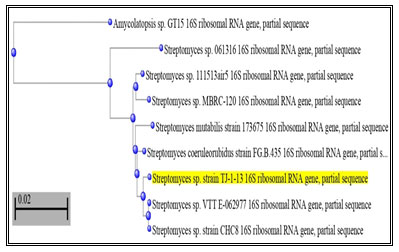
Isolate MM21 was the most active isolates for PHB degradation, thus it was selected for more detail studied. It was grown in medium containing PHB as a carbon source and at the end of incubation period, growth and PHB degradation were measured. Addition of yeast extract at different concentration from 0.0 to 2.5 g/l to medium containing PHB as a carbon source was studied. After 5 days, the growth and PHB degradation were measured.
From the results, it was clear that presence of yeast extract in growth medium enhanced both growth and PHB degradation. Maximum growth measured by dry weight (g/l) was in medium containing 2.5 g/l of yeast extract. Similarly, the highest PHB degradation, measured by enzyme activity (U/ml) was obtained in MSB medium containing 2.5 g/l of yeast extract. The lowest growth and PHB degradation were observed at control which contained 0.0% yeast extract (Figure 3).
Similarly, the isolate MM21 was grown in medium containing PHB as a carbon source in addition to different concentration of glucose, 0.5 to 2.5 g/l to enhance the growth. After 5 days, the growth and PHB degradation were measured. From the results, it was clear that presence of glucose in growth medium enhanced both growth and PHB degradation and the maximum growth measured by dry weight (g/l) was in medium containing 1.0 g/l glucose. Similarly, the highest PHB degradation, measured by enzyme activity (U/ml) was obtained in MSB medium containing glucose (1.0 g/l).
The lowest growth and PHB degradation were observed at control which had no glucose (Figure 4). From the previous results, maximum growth and PHB degradation by the bacterium isolate MM21 was recorded in medium containing PHB as a carbon source in addition to 2.5 g/l yeast extracts and 1.0 g/l glucose.
After 5 days of incubation at different temperatures, 20 to 45°C, the growth and PHB degradation were measured. From the results, it was clear that increasing temperature enhanced both growth and PHB degradation up 25°C, and then the growth and PHB degradation were decreased by increasing incubation temperatures. From the results, maximum growth and PHB degradation was recorded at 25°C after 5 days of incubation whereas the lowest growth and PHB degradations were at incubation temperature 20 and 45°C (Figure 5).
The medium was prepared at different pH values, pH 6.0- pH 8.0. The inoculated flasks were incubated at 25°C for 5 days and growth and PHB degradation were measured. From the results, it was clear that adjusting the initial pH of the medium at 7.0 enhanced the growth, but maximum PHB degradation (U/ml) was recorded at pH 7.5as shown in Figure 6.
Also, MM21 was grown in medium containing PHB as a carbon source, yeast extracts and glucose. All flasks were incubated at 25°C for 3, 4, 5 ,6, 7, and 8 days. At the end of the growth period, the growth and PHB degradation were measured. From the results, it was clear that incubation at 6 days enhanced growth but maximum PHB degradation was measured in the broth medium after 3 days of growth at 25°C. The lowest growth and PHB degradation were observed after1 and 2 days of growth (Figure 7).
From the results, it was clear that presence of PHB in growth medium enhanced both bacterial growth and PHB degradation and the maximum growth was in medium containing 0.5 g/l of PHB. Similarly, the highest PHB degradation, measured by enzyme activity (U/ml) was obtained in MSB medium containing 0.5 g/l of PHB. Increasing the PHB concentrations showed no clear effect on both growth and PHB degradation. The lowest growth and PHB degradation were observed 2.0- 3.0 g/l of PHB as carbon source (Figure 8).
Figure 3: Effect of different concentrations of yeast extract on growth and PHB degradation (U/ml) by the selected isolate Streptomyces sp. MM21.
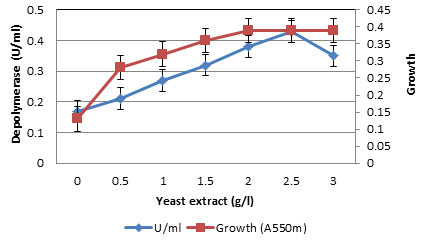
Figure 4: Effect of different concentrations of glucose on growth and PHB
degradation (U/ml) by the selected isolate Streptomyces sp. MM21.
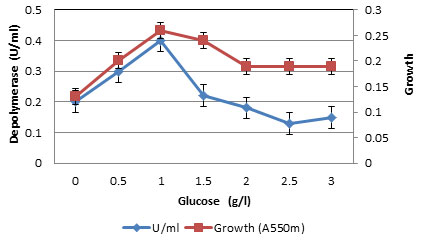
Figure 5: Effect of different temperature on growth and PHB degradation
(U/ml) by the selected isolate Streptomyces sp. MM21.
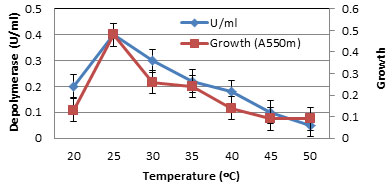
Figure 6: Effect of different pH value on growth and PHB degradation
(U/ml) by the selected isolate Streptomyces sp. MM21.
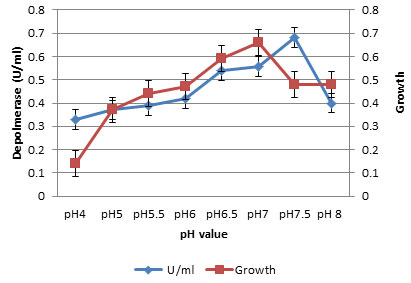
Figure 7: Effect of different incubation period on growth and PHB degradation
(U/ml) by the selected isolate Streptomyces sp. MM21.
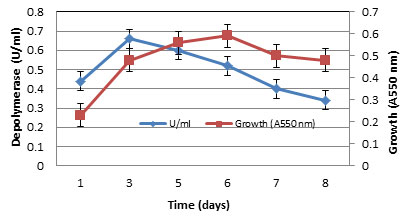
Figure 8: Effect of different concentrations of PHB on growth and PHB degradation
(U/ml). by the selected isolate Streptomyces sp. MM21.
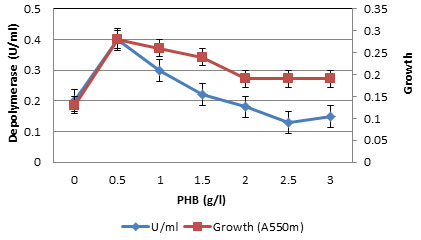
In this study, out of 30 Actinomycete isolates, 8 isolate (27%) were able to degrade PHB in solid and liquid medium. Higher percentage of actinomycetes that can degrade PHB were recorded. Hoang et al., (2007) isolated Actinomycetes from Touchien River in Taiwan and screened them for the ability to degrade poly (ethylene succinate), poly (caprolactone) and/or poly(b-hydroxybutyrate) (PHB) by the clear-zone method. About 135 isolates out of 305 were PHB-degraders (44.2%), 83 isolates were PCL degraders (27.2%), and 64 isolates (21.0%) were PES degraders. Furthermore, 46 isolates could degrade both PHB and PCL (15%), 39 isolates could degrade both PHB and PES (12.8%).
Based on the appearance of isolates, the most important isolates (91.9%) were identified as Streptomyces sp. while Micromonospora genus was represented by 8.1%. In this study, we have evaluated the degradation of poly-hydroxybutyrate by genus Streptomyces (87%) and Amycolatopsis (13%). The isolate MM21, obtained from contaminated soil with oil wastes was the most active isolate in PHB degradation and was identified as Streptomyces sp. MM21.
The maximum ability of the previous bacterium to degrade PHB was observed on solid and in liquid media containing the polymer as the sole carbon source. Degradation process was increased with increasing period of incubation and maximum degradation was obtained after 7 days. The degradation of the polymer was determined on solid medium by measuring the clear zone diameter and in liquid medium by measuring the decrease in the absorbance. On contrast, Mabrouka and Sabryb (2001) used two other methods to detect degradation.
The over layer plate method was applied as an approach to determine the PHB degradation by the tested strain. In contrast to bacteria, fast colonial growth of the Streptomyces strain covered the medium in plates and interfered with reading the clear zone formed. Therefore, the use of test tubes proved to be more advantageous for assaying degradation activity. The synthesis of Streptomyces sp. MM21 depolymerase seems to be highly regulated.
The presence of readily utilizable carbon sources in addition to the polymer in the medium inhibited the degradation process compared to the control (medium containing the polymer only). This indicates that PHB depolymerase expression is repressed in the presence of a soluble carbon source that permits high growth rates. However, after exhaustion of the nutrients, the synthesis of PHB depolymerase is decreased.
This regulation has been reported in many bacteria (Klingbeil et al. 1996). This is consistent with observations of Molitoris et al. (1996) on degradation of polyhydroxyalkanoate by Comamonas sp. but different from those observed with other bacterial depolymerases (Nishida and Tokiwa, 1993). Examination of polymer sheets incubated in sterile medium showed that PHB has a mainly smooth surface with many irregular pits and lesions.
It is assumed that the mycelia growth of the bacterium penetrates the lesions and depolymerases are secreted. Thus, the hydrolysis products increase. As a consequence, the surface area of the polymer accessible to degradation increases. It has been demonstrated that streptomycetes offer excellent potential for degradation of biopolymers in the marine environment (Moran et al., 1995, Alhazmi et al., 2018, Alves et al., 2020).
The degradation of biopolymers helps to overcome some of the pollution problems associated with the use of petroleum polymers. PHB has been investigated for its degradation in many terrestrial and aquatic environments (Jendrossek and Handrick, 2002). Scientist have traditionally used morphology for identifying bacterial species, and even nowadays it is still the potential means of species identification and the newly emerged DNA sequence-based methods have shown higher potentiality for identifying species, thus, molecular techniques were used to confirm the classification.
Many different PHB biodegrading members of Bacillus and Streptomyces have been isolated from soil (Mergaert et al., 1993). Polyhydroxyalkanoic acids are biodegrable plastics that have been extensively studied, because of their similarity to conventional plastics, complete biodegradability and current market domination (Verlinden et al., 2007, Sabapathy et al., 2021).
The biodegradation of plastics proceeds actively under different conditions according to microbe properties and each microbe has its own optimal growth conditions (Lucas el al., 2008). All isolates were screened for depolymerase production on medium containing 0.5% PHB as inducer. Induction and expression are subjected to a complex regulation and depolymerase enzyme is not required for balanced bacterial growth and may be synthesized in response to energy or nutrient limitation (Lodhi et al., 2011).
In this work, the tested bacteria (40% of the tested bacteria) grow on medium containing PHB as carbon source are producer for depolymerase while Aly et al. (2015) reported that more than 50% of the screened actinobacteria were depolymerase producing. Also, Aly et al. (2017) reported that out of 16 fungal isolates, 8 (50%) gave clear zone on solid medium containing PHB as carbon source (Sabapathy et al., 2021).
Depolymerase enzyme detection was obtained either using plate-clearing technique and/or measuring the enzyme activity in liquid medium. Plate-clearing technique was very simple method to detect polymer degradations in agar medium and used to detect the PHB degradation as a clear halo zone around the bacterial colonies (Lodhi et al., 2011). For bacteria, growth on agar medium is usually easier than in broth medium (Choi et al., 2001), thus, no further assessment was conducted for isolates that showed weakly activity on solid agar medium containing PHB as carbon source.
The weak or lack of activity in some isolates may be due to a loss of trait in the isolate or the used culture conditions was not effective in inducing the depolymerase enzyme which are extracellular in fungi whereas the enzymes are either extracellular or intracellular in bacteria. Enzyme assay for these isolates indicated the optimal environmental conditions required for depolymerase enzyme to induce the highest level of biopolymer degradation (Sabapathy et al., 2021).
Among 20 isolates, 8 isolates were proven to biodegrade PHB. The isolates were basically characterized at the morphological level. The knowledge on the participation and role of actinomycetes in hydrolysis of PHB are extremely limited and need to be elucidated in further studies.
This study is important in isolation of some bacterial isolates which produce excellent depolymerase enzyme in the culture supernatant after growth on PHB as carbon source. Although, this enzyme has a wide distribution in bacterial cells and in some algal genera, bacterial depolymerase have considerable potential in commercial applications due to substrate specificity, resistance to proteolysis and catalytic efficiency (Shah et al., 2008, Sabapathy et al., 2021).
Temperature is one of the most critical parameters to be controlled in any bioprocess. A number of mesophilic microbes have been found to be responsible for biodegrading PHB in soil and aquatic environments and many the thermo -tolerant strains are capable of biodegrading PHB at high temperatures ≥ 40°C from soil and compost (Mergaert et al., 1994, Kim, 2000).
Im this study, maximum depolymerase production was at 25°C while Bacillus strain TT96 (Tansengco and Tokiwa, 1998) and Streptomyces strain MG (Tokiwa and Calabia, 2004, Pirttilä et al., 2021) were capable of degradation at higher temperatures. Aspergillus fumigates was able to biodegrade PHB better at 45°C after 24 h of incubation in liquid medium and little information on microbial degradation of PHB at high temperatures was available (Lodhi et al., 2011).
Maximum degradation was after 5 days and there was a gradual decrease in production of enzyme after that. As it is well known, degradation in liquid medium was affected with time. On contrast, Papaneophytou et al. (2009) reported maximum enzyme production by Thermus thermophilus HB8 after 24 h of incubation. The gradual decrease in the production of enzyme after 5 days was as a result of utilization of substrate and other nutrients (Shivam et al., 2009, Kouřilová et al., 2021).
Moreover, maximum enzyme production was at pH 7.5 while Aly et al. (2015) used pH 7 for maximum degradation of PHB by Streptomyces. Increasing pH more than 7.5 affected the charges on the amino acids within the enzyme active site. Similarly, in liquid medium maximum production of PHB depolymerase by A. fumigates was observed at pH 7 after 24 h of incubation (Lodhi et al., 2011) and at pH 9.0 at 65ºC by Bacillus megaterium (Takaku et al., 2006) and at pH 7.5‒8.0 when sewage sludge was used as inoculum (Briese et al., 1994).
In the present study, the maximum production of PHB depolymerase was found at 0.5% of PHB concentration while it decreased with further increase in polymer concentration which might be due to substrate level inhibition (Manna and Paul, 2000). In case of Arthrobacter sp., the optimal concentration of PHB was 0.1% (Asano and Watanabi, 2001). Production of extracellular PHB depolymerase by T. thermophilus was reported after 24 hr of incubation using 0.1% PHB (Papaneophytou et al., 2009).
In the current study, presence of glucose at 1 g/l and yeast extract at 2.5 g/l in the growth medium along with PHB enhanced activity of PHB depolymerases. On contrast, lactose enhanced PHB degradation by A. fumigates (Lodhi et al., 2011). According to Manna and Paul (2000), degradation of PHB by bacterial strains was affected significantly when the PHB containing medium was supplemented with easily consumable carbon sources.
Glucose, fructose and arabinose supplementation lowered the extent of degradation. However, after exhaustion of the nutrients, the synthesis of PHB depolymerase is depressed (Jendrossek and Handrick, 2002, Kouřilová et al., 2021, Kamnev et al., 2021). Inoculum size affect growth and PHB degradation and increasing the quantity increased the growth until certain limit at which there is no increase in PHB degradation (Kamnev et al., 2021).
Degradation increased with increasing period of incubation (Mabrouk and Sabry, 2001, Hidalgo et al, 2013). In accordance with our results are those reported for Pseudomonas lemoignei, (Steinbuchel and Hein, 2001). This result is in good agreement with a previous investigation which demonstrated the importance of carbon sources in the growth medium for enzyme production as the rate of polymer degradation was influenced by the degree and availability of secondary carbon and by the initial carbon source (Shivakumar, 2013, Bhagowati et al., 2015).
Moreover, a PHB biodegrading bacterium Stenotrophomonas sp. RZS 7 was isolated from Indian soil samples of municipal area on minimal salt medium containing PHB as the only source of nutrient. An optimum yield of enzyme was obtained after 5 days of incubation at 37°C and at pH 6.0 (Wani et al., 2016, Kouřilová et al., 2021).
CONCLUSION
Maximum PHB degradation was obtained after growing the selected Streptomyces isolate in medium containing 2.5 g/l yeast extracts, 1 g/l glucose and 0.5 g/l PHB as a carbon source at pH 7 and incubation at 25◦C for 3 days. Many studied are needed for detecting the important characters of depolymerase enzymes which have the main roles in PHB degradation.
ACKNOWLEDGEMENTS
The authors would like to express their deepest gratitude and acknowledge the financial support of Deanship of scientific Research, King Abdulaziz University, Jeddah, Saudi Arabia, (grant number D1432- 139-130).
Conflict of Interests: The authors declare no conflict of interest exist.
REFERENCES
Alhazmi N.M., Ghanem K.M., El Ahwany A., Aly M. and Bokhari F. M. (2018). Degradation of Poly-β-hydroxybutyrate by Trichoderma asperellum. Journal of Experimental Biology and Agricultural Sciences, Vol 6(2): 324 – 334.
Alves L., Santana-Filho A., Sassaki G., de Oliveira Pedrosa F., Maltempi de Souza E., Chubatsu L.S, Müller-Santos M. (2020). 3-Hydroxybutyrate Derived from Poly-3-Hydroxybutyrate Mobilization Alleviates Protein Aggregation in Heat-Stressed Herbaspirillum seropedicae SmR1. Appl Environ Microbiol. 18; 86(17): e01265-20.
Aly M.M., Jaar. T.A. and Bokhari F.M. (2017). Poly- -hydroxybutyrate degradation by Aspergillus fumigates isolated from soil samples collected from Jeddah, Saudi Arabia. IOSR Journal of Pharmacy and Biological Sciences, 12 (1):53-61.
Aly M.M., Tork S., Qari H.A. and Al-Seeni M.N. (2015). Poly-β-hydroxy butyrate Depolymerase from Streptomyces lydicus MM10, Isolated from Wastewater Sample. International journal of agriculture and biology, 17(5): 891-900.
Bhagowati P., Pradhan S., Dash, H.R. and Das S. (2015). Production, optimization and characterization of polyhydroxybutyrate, a biodegradable plastic by Bacillus spp. Bioscience, Biotechnology and Biochemistry, 79: 1454 – 1463.
Briese, B.H., Jendrossek, D. and Schlegel, H.G. (1994). Degradation of poly 3 hydroxybutyrate-co-3-hydroxyvalerate by aerobic sewage sludge. FEMS Microbiol. Lett., 117: 107-112.
Choi Y.M., Suh HJ and Kim J.M. (2001). Purification and properties of extracellular phytase from Bacillus sp. KHU-10. J. Prot. Chem., 20: 287-292.
Gervet B. (2007). The use of crude oil in plastic making contributes to global warming. Luleå University of Technology, pp. 1-8.
Halden R.U. (2010). Plastics and health risks. Annual Review of Public Health, 31 (1): 179-194.
Hidalgo J.G., Hormigo D., Arroyo M. and Isabel D.M. (2013). Novel Extracellular PHB Depolymerase from Streptomyces ascomycinicus: PHB Copolymers Degradation in Acidic Conditions. PLOS ONE, 8 (8): 1-13 e71699.
Hoang K, Lee C. Tseng M. and Chu W. (2007). Polyester-degrading actinomycetes isolated from the Touchien River of Taiwan. World J Microbiol Biotechnol (2007) 23:201–205.
Jendrossek D. and R. Handrick, (2002). Microbial degradation of polyhydroxy-alkanoates. Annu. Rev. Microbiol., 56: 403-432.
Kamnev AA, Dyatlova YA, Kenzhegulov OA, Vladimirova AA, Mamchenkova PV, Tugarova AV. (2021). Fourier Transform Infrared (FTIR) Spectroscopic Analyses of Microbiological Samples and Biogenic Selenium Nanoparticles of Microbial Origin: Sample Preparation Effects. Molecules, 21;26(4):1146
Kim B.S. (2000). Production of poly3-hydroxybutyrate from inexpensive substrates. Enzyme Microbial. Technol., 27: 774-777.
Klingbeil B., Kroppenstedt, R., Jendrossek, D. (1996). Taxonomical identification of Streptomyces exfotialus K10 and characterization of its poly(3-hydroxybutyrate) depolymerase gene. FEMS Microbiol. Lett. 142, 215–221.
Kobayashi T., Sugiyama A., Kawase Y., Saito T., Mergaert J. and Swings J. (1999). Biochemical and genetic characterization of an extracellular poly (3‐ hydroxybutyrate) depolymerase from Acidovorax sp. strain TP4. Journal of Environmental Polymer Degradation, 7: 9‐18.
Kouřilová X, Schwarzerová J, Pernicová I, Sedlář K, Mrázová K, Krzyžánek V, Nebesářová J, Obruča S. (2021). The First Insight into Polyhydroxyalkanoates Accumulation in Multi-Extremophilic Rubrobacter xylanophilus and Rubrobacter spartanus. Microorganisms. 24;9(5):909.
Lodhi A., Hasan F., Abdul Hameed Z., Faisal S. and Shah A. (2011). Optimization of culture conditions for the production of poly 3-hydroxybutyrate depolymerase from newly isolated Aspergillus fumigatus from soil. Pak. J. Bot., 432: 1361-1372.
Lucas N., Bienaime C., Belloy C., Quendeudec M., Silvestre F. and Nava Saucedo J.E. (2008). Polymer biodegradation: Mechanism and estimation techniques. Chemosphere, 73: 424 – 442.
Mabrouka M.M. and Sabry S.A. (2001). Degradation of poly (3-hydroxybutyrate) and its copolymer poly (3-hydroxybutyrate-co-3-hydroxyvalerate) by a marine Streptomyces sp. SNG9. Microbiological Research, 156: 323–335.
Manna A. and Paul A.K. (2000). Degradation of microbial polyester poly 3-hydroxybutyrate in environmental samples and in culture. Biodegradation, 11: 323-329.
Mergaert J., Anderson C., Wouters A. and Swings J. (1994). Microbial degradation of poly3-hydroxybutyrate and poly3-hydroxybutyrateco-3- hydroxybutyrate in compost. J. Environ. Polymer Degradation., 2:177-183.
Mergaert J., Webb, A., Anderson, C., Wouters, A. and Swings, J. (1993). Microbial degradation of poly(3-hydroxybutyrate) and poly (3- hydroxybutyrate-co-3-hydroxybutyrate) in compost. J Environ PolymDegrad., 2 (3): 177–183.
Mergaert J., Wouters, A., Anderson, C. and Swings, J. (1995). In situ biodegradation of poly(3-hydroxybutyrate) and poly (3-hydroxybutyrate-co-3-hydroxyvalerate) in natural waters. Canadian Journal of Microbiology. 41 (31): 154–159.
Moran M. A., Rutherford L. T., Hodson R. E. (1995). Evidence for indigenous Streptomyces populations in a marine environment determined with a 16SrRNA probe. Appl. Environ. Microbiol. 61, 3694–3700
Müller-Santos M, Koskimäki JJ, Alves LPS, de Souza EM, Jendrossek D, Pirttilä AM (2021). The protective role of PHB and its degradation products against stress situations in bacteria. FEMS Microbiol Rev., 5; 45 (3): fuaa058.
Oda Y., Asari, H., Urakami, T. and Tonomura, K. (1997). Microbial degradation of poly(3-hydroxybutyrate) and polycaprolactone by filamentous. Journal of Fermentation and Bioengineering, 80 (3): 265–269.
Papaneophytou C.P., Pantazaki A.A. and Kyriakidis D.A. (2009). An extracellular polyhydroxybutyrate depolymerase in Thermus thermophilus HB8. Appl Microbiol Biotechnol., 83: 659-668.
Pirttilä AM, Mohammad Parast Tabas H, Baruah N, Koskimäki JJ. (2021). Biofertilizers and Biocontrol Agents for Agriculture: How to Identify and Develop New Potent Microbial Strains and Traits. Microorganisms, 13; 9(4):817.
Pranamuda H, Tokiwa Y, Tanaka H (1995). Microbial degradation of an aliphatic polyester with a high melting point poly (tetramethylene succinate). Appl Environ Microbiol 61:1828–1832
Sabapathy P.C., Devaraj S, Anburajan P, Parvez A, Kathirvel P, Qi X (2021). Active polyhydroxybutyrate (PHB)/sugarcane bagasse fber‑based anti‑microbial green composite: material characterization and degradation studies. Appl Nanosci, doi.org/10.1007/s13204-021-01972-8
Sayyed RZ, Wani SJ, Alarfaj AA, Syed A, El-Enshasy HA (2020) Production, purification and evaluation of biodegradation potential of PHB depolymerase of Stenotrophomonas sp. RZS7. PLoS ONE 15(1): e0220095.
Sharma N (2019). Polyhydroxybutyrate (PHB) Production by Bacteria and its Application as Biodegradable Plastic in Various Industries. Academ J Polym Sci 2(3): 1-3.
Shimao M (2001) Biodegradation of plastics. Curr Opin Biotechnol 12:242–247.
Shirling E. B., Gottlieb D. (1966). Methods for characterization of Streptomyces species. Int. J. Syst. Bacteriol. 16, 313–340.
Shivakumar S. (2013). Poly-β-hydroxybutyrate (PHB) Depolymerase from Fusarium solani Thom. Journal of Chemistry, 1: 1-9.
Shivam, K., Tipathi, C.P.M. and Mishra, K.S. (2009). Culture conditions for the production of α- galactosidase by Aspergillus parasiticus MTCC-2796: a novel source. Electrn. J. Biotechnol., 4: 1-9.
Steinbüchel A. and Hein S. (2001). Biochemical and molecular basis of polyhydroxyalkanoic acids in microorganisms. In Biopolyesters, pp. 81-123.
Takaku H., Kimoto A., Kodaira S., Nashimoto, M. and Takagi, M. (2006). Isolation of a Gram-positive poly3-hydroxybutyrate PHB producing bacterium from compost and cloning and characterization of a gene encoding PHB depolymerase of Bacillus megaterium N-18-25-9. FEMA Microbiol. Lett., 64:152-159.
Tansengco M.L. and Tokiwa Y. (1998). Comparative population study of aliphatic polyesters degrading microorganisms at 50°C. Chem. Lett., 10: 1043-1044.
Tokiwa Y (1993). Distribution of poly (b-hydroxybutyrate) degrading anaerobic bacteria. Jap J poly Sci Technol 50:745–746.
Tokiwa, Y. and Calabia, B.P. (2004). Degradation of microbial polyesters. Biotechnol. Lett., 26: 1181‒1189.
Trakunjae C., Boondaeng A. and Apiwatanapiwat W. (2021). Enhanced polyhydroxybutyrate (PHB) production by newly isolated rare actinomycetes Rhodococcus sp. strain BSRT1-1 using response surface methodology. Sci Rep 11, 1896.
Verlinden R., HillD J., Kenward M., Williams C.D. and Radecka I. (2007). Bacterial synthesis of biodegradable polyhydroxyalkanoates J. Appl. Microbiol., 102: 1437-1449.
Wani S.J., Shaikh S.S., Tabassum B., Thakur R., Gulati A. and Sayyed R. (2016). Stenotrophomonas sp. RZS 7, a novel PHB biodegrader isolated from plastic contaminated soil in Shahada, Maharashtra, Western India. 3 Biotech., 6: 179.


